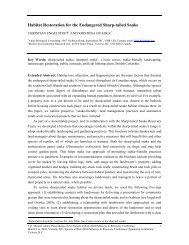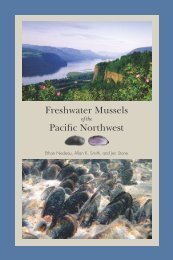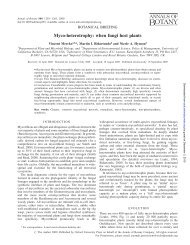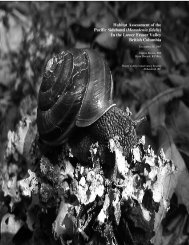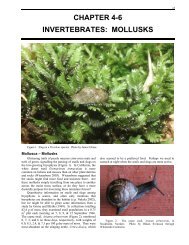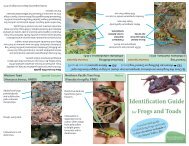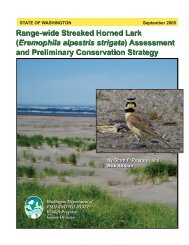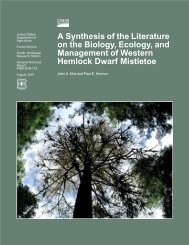Coastal Cutthroat Trout as Sentinels of Lower Mainland Watershed ...
Coastal Cutthroat Trout as Sentinels of Lower Mainland Watershed ...
Coastal Cutthroat Trout as Sentinels of Lower Mainland Watershed ...
Create successful ePaper yourself
Turn your PDF publications into a flip-book with our unique Google optimized e-Paper software.
10<strong>Cutthroat</strong> trout are prized by many co<strong>as</strong>tal estuary, river and lake anglers, but regardlessthey are the le<strong>as</strong>t studied and understood <strong>of</strong> salmonids (Haig-Brown 1960, Anon. 1996).Ironically, their apparent guarded pr<strong>of</strong>ile by anglers h<strong>as</strong> ultimately contributed to <strong>as</strong>carcity <strong>of</strong> habitat and stock status data on co<strong>as</strong>tal cutthroat trout (Raymond 1997),resulting in little trend data on their populations and sport fisheries in British Columbia.Although co<strong>as</strong>tal cutthroat are not routinely censused in their natal streams, <strong>as</strong> aresteelhead and salmon, their geographic distribution is well documented, and they arewidely spread in their range from northern California in the Eel River drainage to SouthE<strong>as</strong>t Al<strong>as</strong>ka in Prince William Sound (Costello and Rubidge 2004). Thus, they areknown to be very broadly distributed throughout co<strong>as</strong>tal British Columbia (Slaney et al.1997), and they are a separate sub-species from westslope cutthroat trout (O. c. lewisi)which inhabit the south e<strong>as</strong>tern Interior. Comparatively, the mature co<strong>as</strong>tal subspeciesh<strong>as</strong> a characteristically large jaw that extends p<strong>as</strong>t the eye, accommodating a highlypiscivorous adult life history. <strong>Co<strong>as</strong>tal</strong> cutthroat are known to have highly variablephenotypic traits and life histories (Costello and Rubidge 2004), where their habitats arehighly <strong>as</strong>sociated with the Pacific rainforest belt (Trotter 1997). Thus, they occur withintwo ecoregions in British Columbia: the Co<strong>as</strong>t and Mountains, and the GeorgiaDepression. Habitats range from small streams to large rivers, bogs to sloughs, ponds tolarge lakes, and co<strong>as</strong>tal lagoons to estuaries and ocean beaches.Life history traits are the most complex among salmonids and include at le<strong>as</strong>t four typesor forms including resident, fluvial, lacustrine and sea-run (Anon. 1997). These formsare present throughout their entire geographic range (Trotter 1997). In addition to thiscomplexity, the relationships between populations with these various life histories largelyremain unknown (Anon. 1997), but mixed life histories within the same population havebeen documented (Anon 1997).As the fisheries literature suggests, many cutthroat populations are depressed relative totheir historical abundance because they have been widely subject to habitat loss anddegradation, <strong>as</strong> well <strong>as</strong> over-fishing (Hall et al. 1997). Numerous local extirpations havebeen documented in the Pacific Northwest (Costello and Rubidge 2004), for which p<strong>as</strong>tintensive hatchery practices are also implicated in some are<strong>as</strong> <strong>of</strong> Oregon and W<strong>as</strong>hington.Further, fishing mortality is considered an important source <strong>of</strong> risk, b<strong>as</strong>ed on statusreviews in the 1990s <strong>as</strong>sociated with the US federal Endangered Species Act (ESA)(Johnson et al. 1999). Clearly, in the US Pacific Northwest, it is the anadromous formthat is <strong>of</strong> greatest conservation concern owing to some serious declines in major stocks.The status <strong>of</strong> cutthroat h<strong>as</strong> also been reviewed in British Columbia, albeit highlyconstrained by the sparseness <strong>of</strong> available data. Further, anadromous cutthroat weresurveyed qualitatively <strong>as</strong> part <strong>of</strong> a larger American Fisheries Society investigation <strong>of</strong> thestatus <strong>of</strong> salmon and trout. Five co<strong>as</strong>tal cutthroat populations in the <strong>Lower</strong> <strong>Mainland</strong>Region were judged <strong>as</strong> extinct, and four <strong>as</strong> at high risk <strong>of</strong> extinction, but the status <strong>of</strong>most (80 %) were unknown (Slaney et al. 1997). Populations in adjacent streamspossibly formed a separate stock, which added complexity to the review. More recently,the Committee on the Status <strong>of</strong> Endangered Wildlife in Canada (COSEWIC) examined



